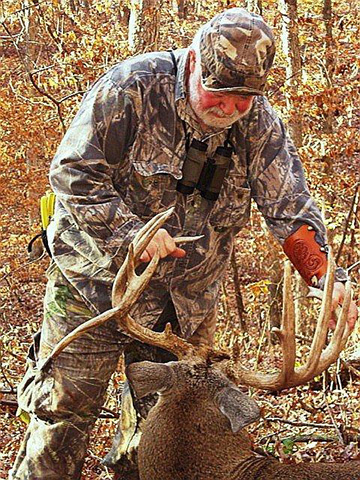Bowsite.com
The Nation's Leading Bowhunting Website
Over the years I've been blessed to shoot a lot of great bucks. Some people think I have a super hot spot. I don't. Without bragging, I've done it all over the U.S. for many years. Some people think I'm extraordinarily lucky. I'm not. In fact, if anything I tend to be unlucky in the woods. But I do work hard at it and MAKE it happen. I don't mean to say I'm forcing it to happen, I mean I set up the situation and then sit back and patiently wait for what I know will eventually come. One of my primary hunting strategies is hunting terrain structures. Land contours are one of the only things that remain relatively constant year after year. There will be annual deviations that might include fallen timber; vegetation changes, including both the under-story and overhead canopies; fire and/or logging damage, as well as mast crops and agricultural variations. But adjusting to those changes is one of the reasons it's so much fun, and hopefully rewarding.
The fact is one of the most consistent things you can count on when dealing with whitetails, and especially mature whitetails, is their use of the terrain - that along with their survival senses. I've been doing my whitetail "boot-camps" for upwards of ten years now. I only do them in the early spring because I prefer to do them with no snow on the ground, yet before lush green vegetation hinders reading the sign. One of the most common comments I get is how I focus on a structural feature then manipulate that structure to shift deer movement closer to me. Discuss this articleI happen to hunt with a recurve bow instinctively. I always have and hopefully always will. But because of getting up in years, as well as physical limitations due to health issues, I'm not as good of a bow shot as I used to be when I was in my prime. In recent years I'm more of a 20 yard 'max' guy but much prefer 12 to 15 yard shots. In other words, I scout until I find terrain features that will concentrate normal movement patterns. Then I manipulate that normal, unrestricted movement IF NEEDED to my advantage. By tweaking a situation slightly I may be able to shift a normal 25 yard shot down to under fifteen yards. The close relationship to my target just adds to the satisfaction of my reward. It's not cheating, it's just common sense and smart hunting. A very common mistake I see a lot of guys make is not looking at a big enough picture. They might or might not be in the ballpark, but most tend to only consider at far as they can visually see. One of the things I always try to point out is you need to consider what's out of sight, over the horizon. In other words, say you are able to see fifty yards in the timber to the horizon, you need to top out and walk the timber on the other side to see if there's some structural deviation that will make a certain spot better than the one that "appears" the same but might be only seventy yards (or whatever) away. If, for example, there is a density, an edge, a stone wall, an old fence, or a beaver pond just over the horizon you need to know it and add it as another piece to the puzzle. That little tidbit alone could - very possibly- double your chances for success. If you do not live in snow country you are missing out on a great learning tool. Tracking and/or back-tracking deer on snow is extremely valuable. Following UNDISTURBED deer tracks on snow will (in one day) teach you more than you could learn in a month - on bare ground. After correctly determining natural movement patterns you can then shift those patterns to your advantage. All it takes is a little common sense and reason in order to greatly increase your chances of success. This is also a great opportunity to spend time with youngsters in both a learning, and a teaching situation. Not only will you be offering the much needed bonding in today's world, but you'll have an added opinion (theirs) to consider. Often you'll find you just might learn something when considering a younger, and possibly more simplistic view. Not only will this intense scouting be both a physical and mental workout but it will build your confidence because you'll KNOW you're in the right place. It will also increase your self-satisfaction and build your confidence even more so when the big boy does exactly what you knew he would do . It wasn't just luck. It was hunting rather than just shooting. I can't stress this enough; Time spent in the woods learning, using woodsmanship and common sense can help dictate your "luck." It will add positively to your overall experience. And the best part is you'll be able to now adapt your new knowledge and utilize it for the rest of your life. Hopefully you can hand that wisdom down to the next generation. Get out there and make your own luck. You will find it's extremely rewarding. |


.jpg)





